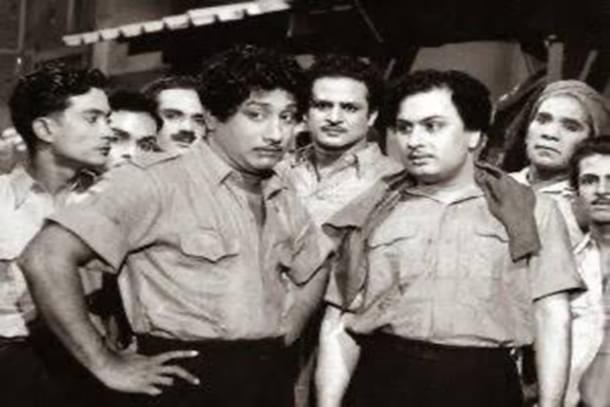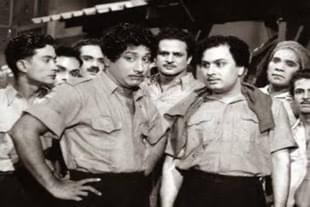Movies
When MGR Threw Sivaji Under The Bus By Dropping A Hint About A Well-Kept Secret
K Balakumar
Jul 07, 2024, 02:12 PM | Updated Aug 29, 2024, 01:03 PM IST
Save & read from anywhere!
Bookmark stories for easy access on any device or the Swarajya app.


Last week, even as actor Vijay's fans were celebrating their hero's birthday on social media timelines, behind-the scenes pictures from the shooting of his arch rival Ajith also dropped.
Now, Ajith doesn't do official interviews or interactions anymore. News about him are gleaned from such carefully let out leaks. That his team chose to make one on the day of his chief competitor Vijay's birthday did not go well with the latter's followers. They termed it as a cheap ploy as, in their limited view, the occasion belonged to Vijay.
Of course, such notional fights are monumentally silly, and don't really matter. Having said that, it is equally a fact that the stars themselves sometimes throw up potential stuff to ignite fan battles.
In the past, even when there was no social media, stars used to stir up controversies by some revelations or having planted news against their rivals. This has happened with Rajinikant and Kamal Haasan, the most famous rivalry in Tamil cinema.
Their predecessors M G Ramachandran (MGR) and Sivaji Ganesan were even more known for their conflicts, even if they presented a picture of bonhomie between themselves outside. The fact that both MGR and Sivaji had political ambitions made their exchanges sharp and innuendo-filled.
MGR’s Leading Hint Aimed At Sivaji
Both started in the same Dravidian pantheon, and at one point, even if MGR had an earlier start in films, it was Sivaji who was more of a darling to the Dravidian crowd. The success of his debut vehicle Parasakthi (1952), which had Dravidian rhetoric-filled dialogues by M Karunanidhi, made it easy for the assimilation.
But the equation between Sivaji and DMK soured quickly and by 1956 he was out of the party after his visit to Tirupati. It was gossiped at that time that MGR had a covered hand in the exit of Sivaji from the DMK. There was also an allegation that Karunanidhi and MGR joined forces to elbow out Sivaji.
Anyway, the point is the equation between MGR and Sivaji seemed loaded, even though both the actors had the maturity to rise above that from time to time. But things were made worse by the hangers-on of the two stars. And also things took some personal level animosity sometimes.
It sure did in the 1970s when MGR was writing about his own life in the Tamil magazine Ananda Vikatan under the title Naan Yen Piranthen (which itself was the name of his own movie that was released in 1972). It was the period when MGR's political career was getting to its zenith.
In that memoir, which was serialised every week by the magazine, MGR wrote about his own drama troupe in the early 1950s and how Sivaji would visit the drama auditorium in Coimbatore every day without fail.
The stress in the last reference (every day without fail) was apparently a deliberate choice. And it triggered an avalanche of speculation (which in itself could have been orchestrated from behind). Anyway, the question that was asked was: Why did Sivaji visit MGR's troupe daily without fail?
Cue for the introduction of: A G Rathnamala.
An actress and singer, who was the leading lady in the MGR troupe at that time. She had a stint in MGR's drama team before she was dropped. She had been acting and singing in films since 1950. Her speciality was comedy songs along with the likes of Chandrababu, A L Raghavan and S C Krishnan. And this was one of her famous songs, Azhagana Chinna Ponnu, in MGR's Thirudathe (1961).
But the biggest song in her career was the ever-popular maudlin hall of famer Pogathe Pogathe En Kanava in Veerapandia Kattabomman (1959). As it happened, Rathnamala was the lead heroine in Veerpandia Kattabomman when Sivaji had staged it as a drama. They made a lovely combination on stage.
Rathnamala, A Woman Of Dignity And Grace
And the rumour at that period was that Sivaji and Rathnamala were more than a cinema pair, they were in real life too. To put it bluntly, the gossip mill had it that the two were married. She lived in a house in Madras' T Nagar that had the name board 'Rathnamala Ganesan'.
By all accounts available from that time, Rathnamala was a lady of character. It was said that she insisted that Sivaji should not make their relationship as it would affect his film career. It was also said that their relationship also saw the birth of a girl who was much later married off to a person connected to the film world.
The news of Sivaji's dalliance with Rathnamala was, of course, a matter of whisper among a select few. But after MGR dropped a leading hint in his memoir in the 1970s, one of his long-time associates, the journalist Manian, picked it up and gave it more air.
Manian owed his entire career to MGR, and he was known to write stuff that would please his master. Strangely, he picked a film from the 1960s, Iru Malargal (1967), a Sivaji starrer, about a man caught in the cross winds of his wife and lady love.
One of the lies from Manian, and it was mischievous, and it read to the effect that Sivaji, like in his real life, portrays the predicaments of a man with two wives. This was an unkind and deliberate shot, especially since he was writing about a film that had been released almost a decade back.
Reliable accounts from then say that Sivaji was mighty upset, and MGR himself repented the turn of events. He reportedly mollycoddled Sivaji with some kind of offer. But Sivaji never forgave Manian for his cheap act.
Anyway, MGR's implicit reference to Sivaji's affair was removed when his Vikatan series was later compiled and released as a book.
As far as Rathnamala was concerned, she kept herself away from controversies and maintained her dignity and also safeguarded those connected with her. In 2007, on 3 June, she died a lonely death in T Nagar residence.
She had sung over 100 songs in films. But in life, and in death, she remained unsung. Worse, she was reduced to being a pawn in a larger game between two stars.





